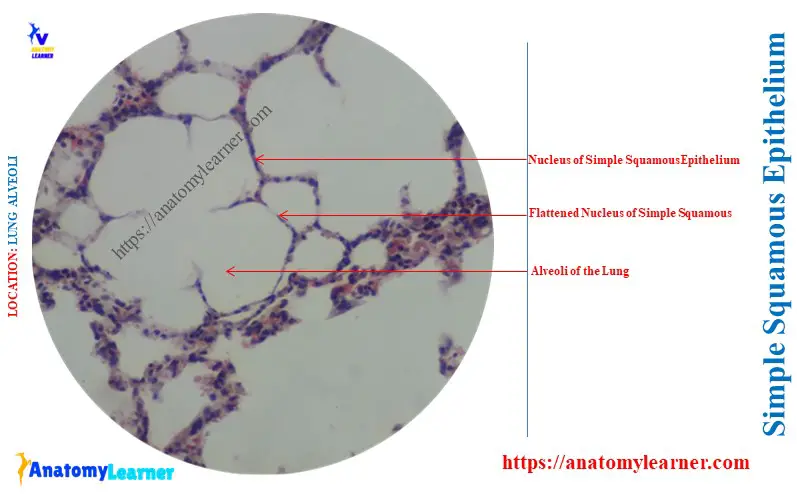The simple squamous epithelium has a wide variety of distribution in the animal body. Here, you will know the answer to the question – ‘Where is simple squamous epithelium found’?
Quick answer: the simple squamous epithelium is found in the serous membrane of the body cavities, the internal surface of the heart, and the luminal surface of the blood vessels. It is also found in the lining of the alveoli, anterior chamber of the eye, glomerular capsule, and loop of Henle of the nephrons.
Other than these organs, you will find the simple squamous epithelium in the animal body that I will discuss here. I will provide the main identifying points of the simple squamous epithelium from the animal body with the diagram.
Thus, you will easily identify the simple squamous under the light microscope from different organs of the animal body. Let’s learn the characteristics, features, and location of the simple squamous from the animal body.
Where is simple squamous epithelium found?
The simple squamous epithelium lines the moist internal surface of the animal body. Following are the organs where you will find the simple squamous epithelium lining –
Serous membrane of the body cavities like the pleural, pericardial, and peritoneal cavities,
- The internal surface of the animal heart,
- Luminal surface of the blood and lymph vessels,
- The lining of the pulmonary alveoli of the lung,
- In the anterior chamber of the eye,
- Internal surface of the tympanic membrane of the ear,
- Membranous labyrinth of the internal ear,
- In the lining of the glomerular capsule (Bowman’s capsule) and
- Different parts of the loop of the nephron (renal tubules),
When the simple squamous epithelium lines the serous pleura, pericardium, and peritoneum, they are termed the mesothelium. Again, the simple squamous lines the heart’s inner surface, known as the endocardium.
Finally, the simple squamous lines are the blood’s luminal surface, and lymph vessels are termed the endothelium.
Here, the diagram shows the appearance of the simple squamous epithelium from the lining of the lung alveoli. It only shows the single-layer flattened nuclei under the light microscope.
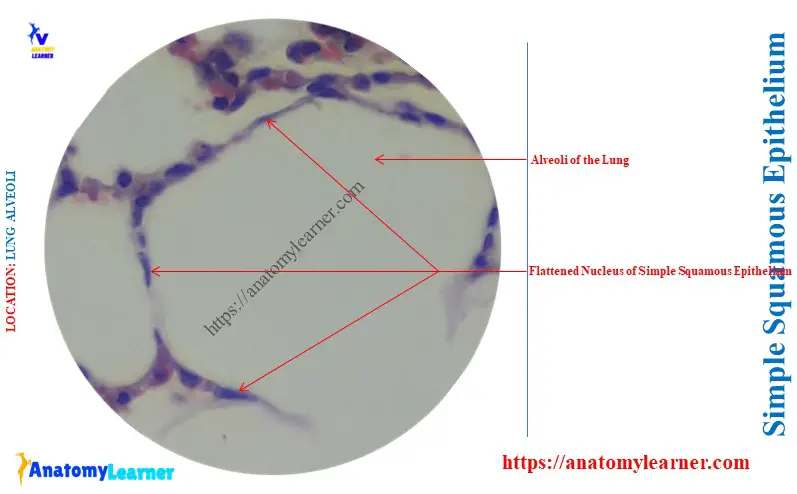
What is simple squamous epithelium?
The simple squamous epithelium is a single layer of thin, flat, and scalelike cells. These cells rest on the basement membrane with considerable length and breadth.
They have negligible height and possess centrally placed flattened nuclei. Under the light microscope, you will only see the cells’ flattened nucleus and indistinct plasma membrane.
Key features of the simple squamous epithelium:
- Cell layer: single
- Cell shape: thin, flattened, and scalelike,
- Nucleus shape: single flattened nucleus,
- Location of the nucleus: center of the flattened cell,
Here, the diagram shows the thin, flattened, and scalelike simple squamous cell under the microscope. It also shows the single flattened nucleus at the center of the flattened squamous cell.
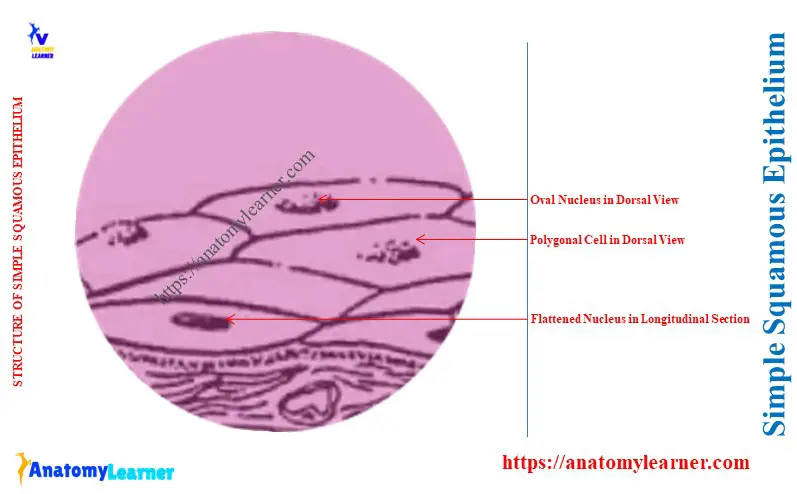
Appearance of the simple squamous epithelium
The simple squamous has an irregular shape with a slightly serrated border on the surface view. These irregularly shaped cells fit together to form a continuous sheet. You will find the spherical or oval nucleus near the center of the simple squamous cells.

On the cross-section, the simple squamous cells appear thicker in the area of the nucleus. It also possesses thin attenuated strands of cytoplasm on either side.

The cells appear flattened, their height much smaller than their width in the longitudinal section. Again, the cytoplasm of the cells forms a thin layer, and nuclei produce the building of the cell surface.
A simple squamous example from the Bowman’s capsule
The parietal layer of the Bowman capsule of the animal kidney shows the simple squamous lining. You may easily identify the renal corpuscle of the kidney as a rounded structure under the low magnification of the light microscope.
Each of the corpuscles is made up of a central darky-stained capillaries. A urinary space (Bowman’s space) surrounds the darkly stained capillaries of the corpuscle.
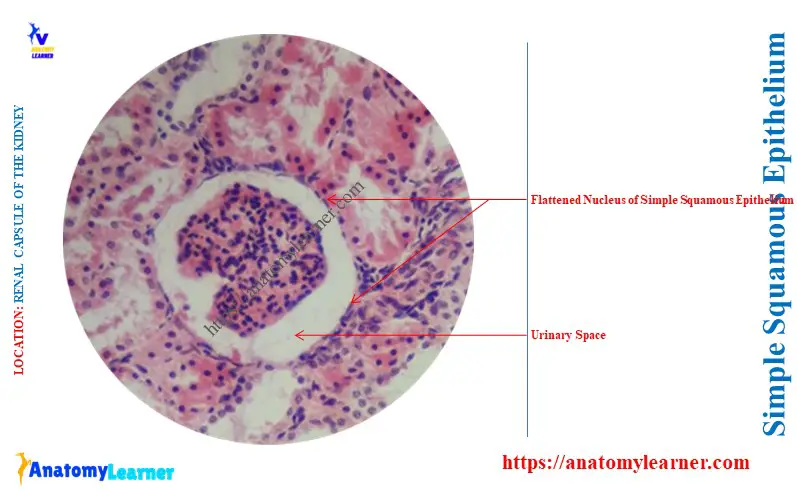
This space is limited externally by the parietal layer of the Bowman’s capsule. In this parietal layer, you will find the simple squamous epithelium.
But, you need to observe these simple squamous from the parietal layer of the capsule under higher magnification. Here, the higher magnification of the renal corpuscle shows the simple squamous epithelium lining.
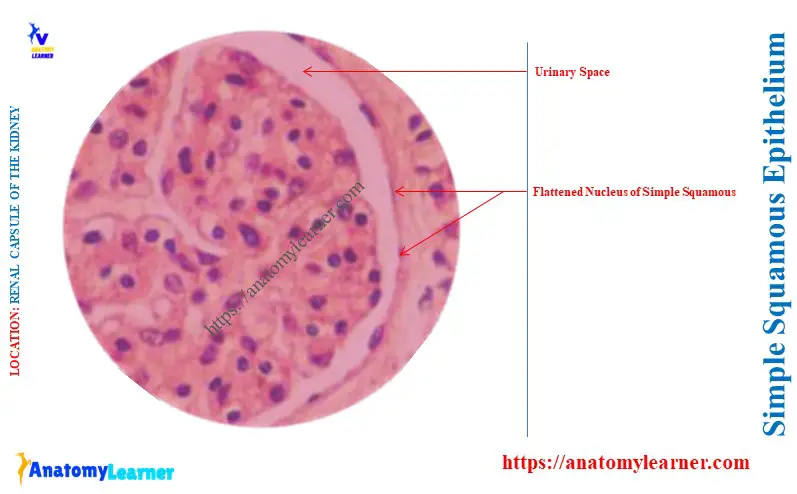
The outline of these simple squamous from the renal capsule is indistinct. Again, their shape may be ascertained by the dark flattened nuclei and scanty cytoplasm.
Where is simple squamous epithelium found in the respiratory system?
Answer: the simple squamous epithelium in the respiratory system is found –
- The lining of the pulmonary alveoli of the lung,
- The alveolar sac of the lung, and
- Pulmonary blood vessels of the lung,
Here, the diagram shows the simple squamous lining from the different parts of the animal respiratory system.
Where is simple squamous epithelium found in the lungs?
Answer: you will find the simple squamous epithelium in the alveoli and alveolar sac of the lungs. Here, the diagram shows the simple squamous (flattened nuclei) from the alveoli of the lung.

The epithelium of the lung alveoli is flattened in the longitudinal section. These cells appear so thin that their nuclei produce bulging on the surface. On the surface view of these alveoli epithelium, they show the polygonal outline.
Conclusion
So, you got the answer to the question – ‘Where is simple squamous epithelium found?’. The serous membrane, the internal surface of the heart, vessels, and the renal capsule are lined with the simple squamous epithelium. Again, the lung alveoli, different parts of the ear, and anterior chamber of the eye also line with the simple squamous epithelium.

